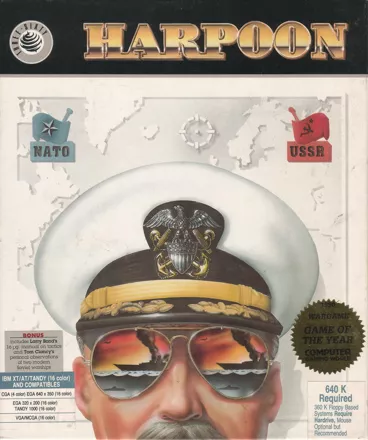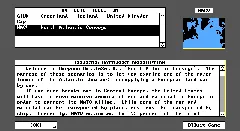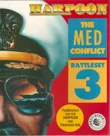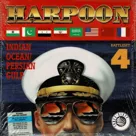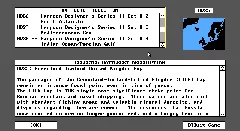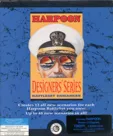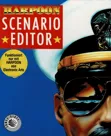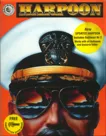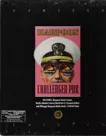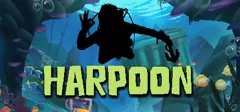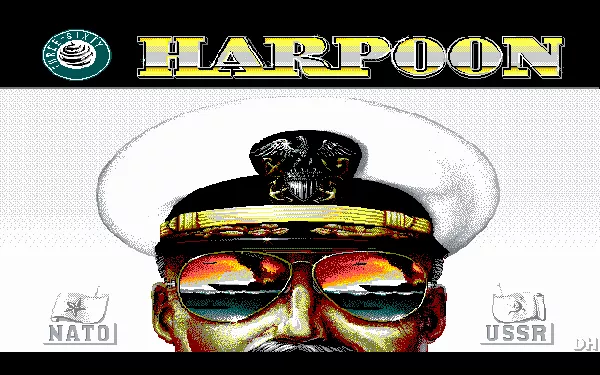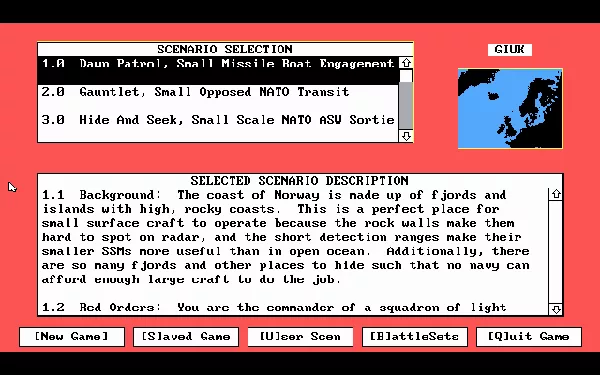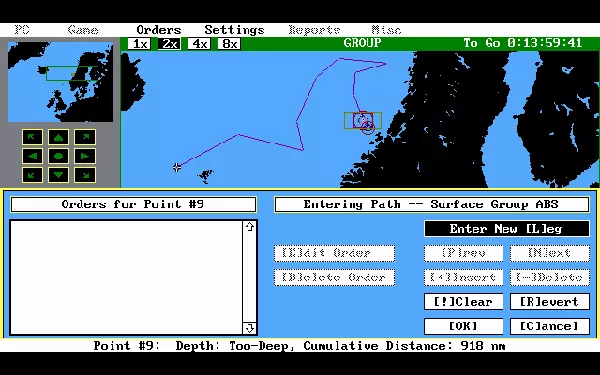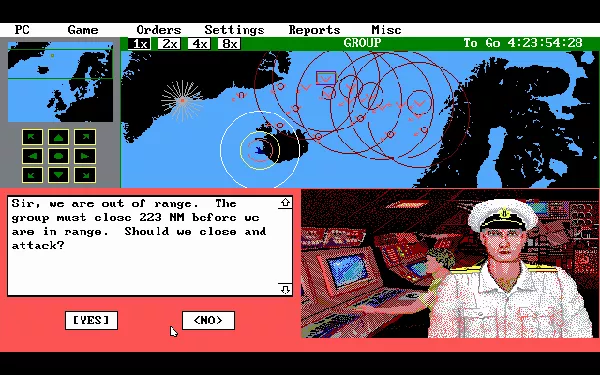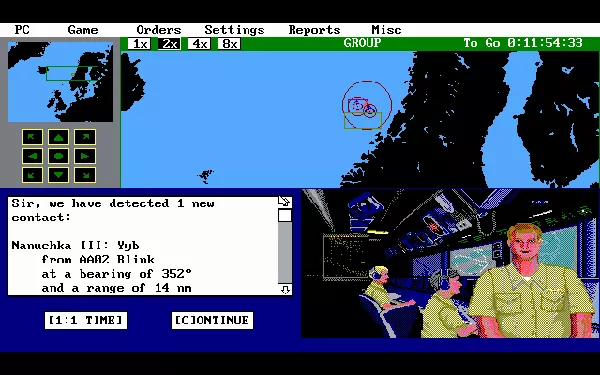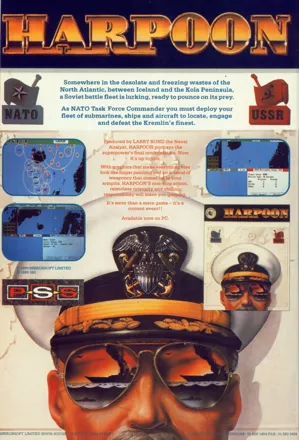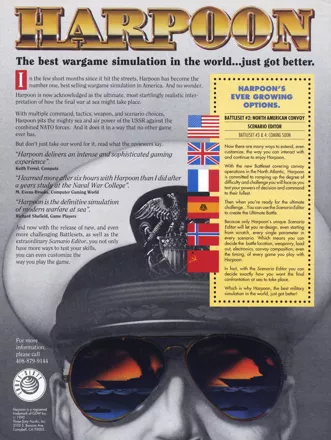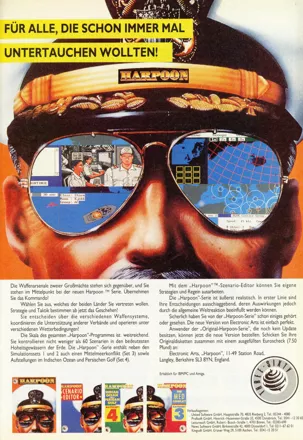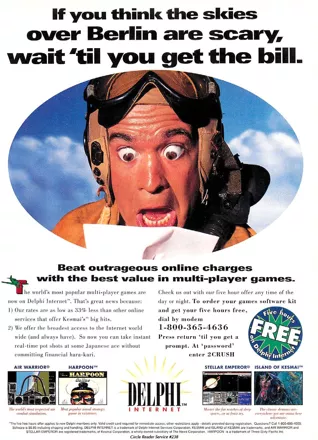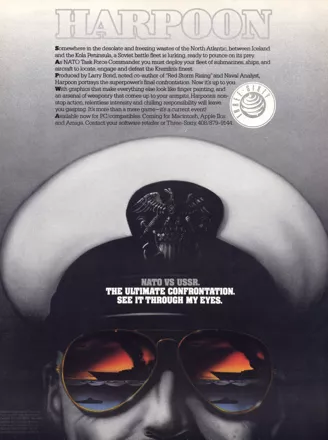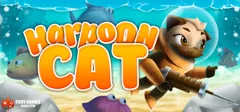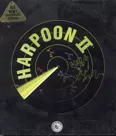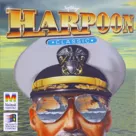Harpoon
Description official description
A modern naval battle simulator based on Larry Bond's popular Harpoon board-game from 1980. The game features 13 possible Cold War scenarios, each of which can be affected by multiple factors.
You can choose from an authentic arsenal of over 100 Soviet and NATO weapons. Use sensors, radars and sonar to track enemy ships. Crucial information on capabilities can be checked from the informative database.
The original version of the game contains one main battleset called Greenland/Iceland/United Kingdom Gap (GIUK). Later, several additional battleset data disks and a Scenario editor were released.
Groups +
Screenshots
Promos
Credits (DOS version)
8 People
| Original Computer Harpoon Design Team | |
| Original Computer Harpoon Programming Team |
Reviews
Critics
Average score: 81% (based on 12 ratings)
Players
Average score: 3.9 out of 5 (based on 9 ratings with 1 reviews)
One of the best naval simulations of 1980s.
The Good
The game was very realistic compared with the other naval simulations of the time it was released. There were a great number of missions shipped with the original game and many additional battlesets were released later on. A scenario editor was also available. The larger battles were really complicated and it took hours or even days of intensive playing to beat them. Radar and sonar detections worked just like in the real life, weapons were not unrealistically accurate and larger ships took numerous hits to sink. Weapon reloads and aerial refuelling were also available, as well as numerous weapon layouts for the aircraft. This was also one of the very few naval simulations which included the possibility of actually using nuclear weapons. It was very rewarding when after a long battle against an American carrier battle group one of the AS-4 Kitchens fired by a flight of Tu-22M Backfires at last got through the defenses, hit the carrier and obliterated it, as well as all other ships nearby.
The Bad
It was a bit hard to configure my system to run this game as it required almost 600K free basic memory. The original version crashed every now and then (fortunately it was possible to save the game any time wanted), which was very annoying after a couple of hours of playing. The updates eventually fixed most of the crashes, but not all of them.
The Bottom Line
A naval simulation in which you play on either the NATO or Soviet side. The units available include all kinds of aircraft, ships and submarines of the both sides. You can control both the groups and individual units. The game supported numerous sound cards and you could choose between EGA and VGA graphics. The music in the original game consisted mainly of beeps and other PC speaker sounds associated with incoming messages and missile launches etc. When you sank a ship, there was a MIDI anthem of either USSR, UK or USA, depending on the side you played. One of my favourite games back then, nowadays I play the Windows version called "Harpoon Classic" instead. It has all the battlesets made for the DOS version and requires no additional memory configurations, but misses aerial refuelling and weapon reloads for ships.
DOS · by NH (479) · 2003
Discussion
| Subject | By | Date |
|---|---|---|
| Harpoon: The Next Mission | Infernos (49628) | Jul 9, 2018 |
Trivia
Origins
Larry Bond first created Harpoon in 1980 as a paper-based miniatures game. Bond was a serving officer in the U.S. Navy at the time.
Book Research
Author Tom Clancy used the paper version of Harpoon while writing The Hunt for Red October, published in 1984. Clancy later teamed up with Larry Bond writing Red Storm Rising, published in 1986. The game was used to model many of the naval battles depicted in the book.
Programming Details
The Harpoon software engine contained over 115,000 lines of code, with most written in the C programming language and the remainder in Assembly. The original program was 426K and supported (through separate graphics files) CGA, Tandy, and EGA video formats. After 30-months of development, and at the cost of over $300,000, the computer game was released for IBM PCs on December 17, 1989.
Macintosh Version
When launched a year later, the Macintosh version worked with System 6.0.2 or above and used monochrome graphics; however, a 16-color Macintosh version was available as a $15 upgrade.
Awards
- Computer Gaming World
- September 1990 (Issue #74) – Wargame of the Year
- March 1992 (Issue #92) – Introduced into the Hall of Fame
- November 1996 (15th anniversary issue) - #40 in the “150 Best Games of All Time” list
Analytics
Upgrade to MobyPro to view research rankings and price history! (when applicable)
Identifiers +
Contribute
Are you familiar with this game? Help document and preserve this entry in video game history! If your contribution is approved, you will earn points and be credited as a contributor.
Contributors to this Entry
Game added by tkcmd.
Macintosh added by Rola. PC-98 added by Infernos. Amiga added by Martin Smith.
Additional contributors: PCGamer77, Indra was here, Rola, Patrick Bregger, Retro Viator.
Game added January 30, 2003. Last modified June 20, 2024.


